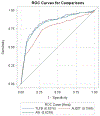Comprehensive Assessment of Alcohol Consumption in People Living with HIV (PLWH): The New Orleans Alcohol Use in HIV Study
- PMID: 32441814
- PMCID: PMC7282973
- DOI: 10.1111/acer.14336
Comprehensive Assessment of Alcohol Consumption in People Living with HIV (PLWH): The New Orleans Alcohol Use in HIV Study
Abstract
Background: High frequency of alcohol use among people living with HIV (PLWH) warrants careful assessment and screening to better understand its impact on HIV disease progression and development of comorbidities. Due to the limitations of the tools used to measure alcohol use, the links to health consequences are not fully understood.
Methods: We completed a cross-sectional analysis to examine the prevalence of alcohol consumption using multiple alcohol assessment tools and their correlation and consistency in a cohort of PLWH (N = 365) enrolled in the New Orleans Alcohol Use in HIV (NOAH) Study. Alcohol use was assessed with the Alcohol Use Disorders Identification Test (AUDIT), timeline followback (TLFB) Calendar, lifetime drinking history, Alcohol and Drug Addiction Severity Index, and blood levels of phosphatidylethanol (PEth). Spearman's correlations were estimated for continuous measures of alcohol consumption; Wilcoxon rank-sum tests were used to compare means; and logistic regression was used to estimate odds of alcohol use by demographic characteristics.
Results: Self-report of current alcohol use varied from 58.9 to 73.7% depending on the assessment. All the self-reported alcohol measures showed statistically significant correlations with the biological marker PEth. The highest correlation was with TLFB grams (r = 0.67, p < 0.001). Using TLFB, 73.7% of the cohort reported using alcohol in the last 30 days, and 61.6% had a positive PEth value. The prevalence of risky drinkers, meeting the TLFB > 3 (women) or >4 (men) drinks/day or>7 (women) or>14 (men) drinks/week, was 49.0%. Medium-risk drinking defined as an AUDIT score ≥ 8 was reported in 40.3%, and high-risk drinkers/probable AUD (AUDIT score ≥ 16) was met by 17.0% of the cohort.
Conclusions: Our results demonstrate the importance of comprehensive assessments for alcohol use, including self-report via multiple assessment tools administered by trained staff, as well as the addition of biomarkers for improved classification of subjects into different drinking categories.
Keywords: Alcohol; Alcohol Use Disorders; HIV; Phosphatidylethanol.
© 2020 by the Research Society on Alcoholism.
Figures


References
-
- ARADOTTIR S, ASANOVSKA G, GJERSS S, HANSSON P & ALLING C 2006. PHosphatidylethanol (PEth) concentrations in blood are correlated to reported alcohol intake in alcohol-dependent patients. Alcohol Alcohol, 41, 431–7. - PubMed
-
- BOHN MJ, BABOR TF & KRANZLER HR 1995. The Alcohol Use Disorders Identification Test (AUDIT): validation of a screening instrument for use in medical settings. J Stud Alcohol, 56, 423–32. - PubMed
Publication types
MeSH terms
Substances
Grants and funding
LinkOut - more resources
Full Text Sources
Medical
Miscellaneous

